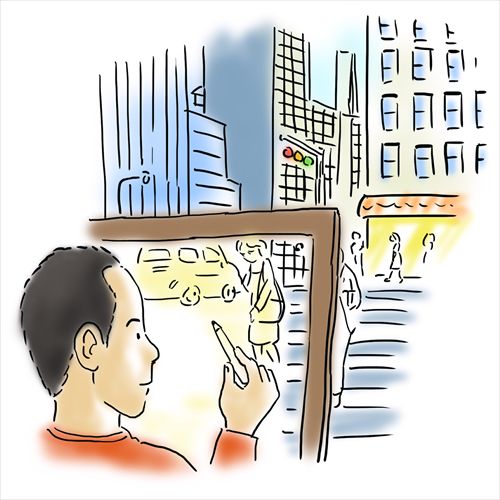HOME >> OP-ED
Chinese street artists take to American way of protest in NY
By Rong Xiaoqing Source:Global Times Published: 2015-10-8 21:23:01

Illustration: Liu Rui/GT
New York's Times Square is a magnet for tourists from the world. But to New Yorkers, it is a place we know but often try to avoid. We have some pride in it as the crossroads of the world, but we don't talk about it too much. It is a pulsating, vibrating place of chaos, gridlock and hustle - some people actually call that fun.
So when Times Square regularly gets into the headlines of local tabloids, it is more often than not a sign of major trouble.
In the past year that may well have happened more often than at any other time since the former haven for prostitutes and drug addicts was turned into a family-friendly tourist heaven in the late 1990s when Rudy Guiliani was the city's mayor.
At first it was the Supermen and Sponge Bobs - not the real deal, alas, but people dressing in costumes of popular cartoon figures to solicit tourists for photos and get a few bucks as tips in return. But some of them have been too aggressive, chasing tourists for tips and cursing those who dare to defy them.
Then it's the topless women whose bodies are turned into a canvas for the stars and stripes. There was outrage that families were confronted by such nudity in the middle of the day, that the women heralded a slide back to the bad old days of sleaze, that some of the women were exploited by their male partners.
With some of the newspapers in full outcry, the city government took notice. The current mayor, Bill de Blasio, planned at first to get rid of the pedestrian areas in the square where all these street workers ply their trade. That didn't fly so the New York police dispatched 100 more officers to the area to keep trouble makers in order. But this obsessive focus has claimed some unintentional victims; Chinese street artists who draw portraits for tourists or sell other art products on the street to make ends meet.
In late September, a dozen or so Chinese artists rallied at Zuccotti Park in Lower Manhattan, at one time the ad hoc headquarters for the Occupy Wall Street Movement.
They complained about a dramatic increase in the number of tickets the police have issued to them since August. Many times, the tickets were handed out on shaky grounds. For example, artists have been targeted for being too close to a bus stop even when there is no sign that it is interfering with bus services.
One artist said he got nine tickets within a week. Another got a second ticket when he questioned the police officer and tried to take down his badge number. The tickets can often be dismissed by courts later without any need to pay fines. But the artists have to take the best part of a day off of work to go to court.
Sometimes it can be worse. Shi Meifang, who makes and sells grass handcrafts in Times Square said she was arrested and detained for a few hours when she tried to use her phone to film an officer issuing her a ticket.
None of this is natural for the normally quiet Chinese artists.
Since the 1980s, Chinese artists who have come to the US to study have been drawing portraits and caricatures on the streets to make a living.
But in recent years, this group has been growing dramatically. Some new immigrants who may not have professional training in arts quickly pick up some drawing skills. Walking in Times Square, you can find at least a few stands of Chinese artists on just about every block.
Compared to others working Times Square, the Chinese artists may be the most mellow ones. They are normally laid back and friendly. They only stretch their arms out to tourists and invite the latter to sit down for a portrait every now and then.
But even this represents an evolution. Some who have been working on the streets for many years still remember their red faces, speeding heart beats and the awkwardness when potential customers asked about their prices. Now they laugh at their own long-gone shyness. They have learned to discover the best spots in Times Square to place their stands, secure coveted spots from competitors, promote their businesses to strangers passing by, detect potential customers from a distance and persuade them to do a portrait or buy photographs.
And they even learned the American way of fighting for their rights. At the rally, the artists appeared with advocates from the Street Vendor Project, a rights organization committing to fight for them. Many of them told me they had no experience of protesting against the authorities, but thought it's fine because "this is America."
There may only be one thing left that shows that these Chinese artists are not completely Americanized just yet. Many of them don't like to disclose their real names to reporters from Chinese language media. They say they don't want their family members and friends in China to know that they work on the streets in the US.
While American street artists often boast about their experience to anyone who'd like to listen, Chinese or Chinese American artists are still burdened by the face issue.
The author is a New York-based journalist. rong_xiaoqing@hotmail.com
Posted in: Viewpoint, Rong Xiaoqing